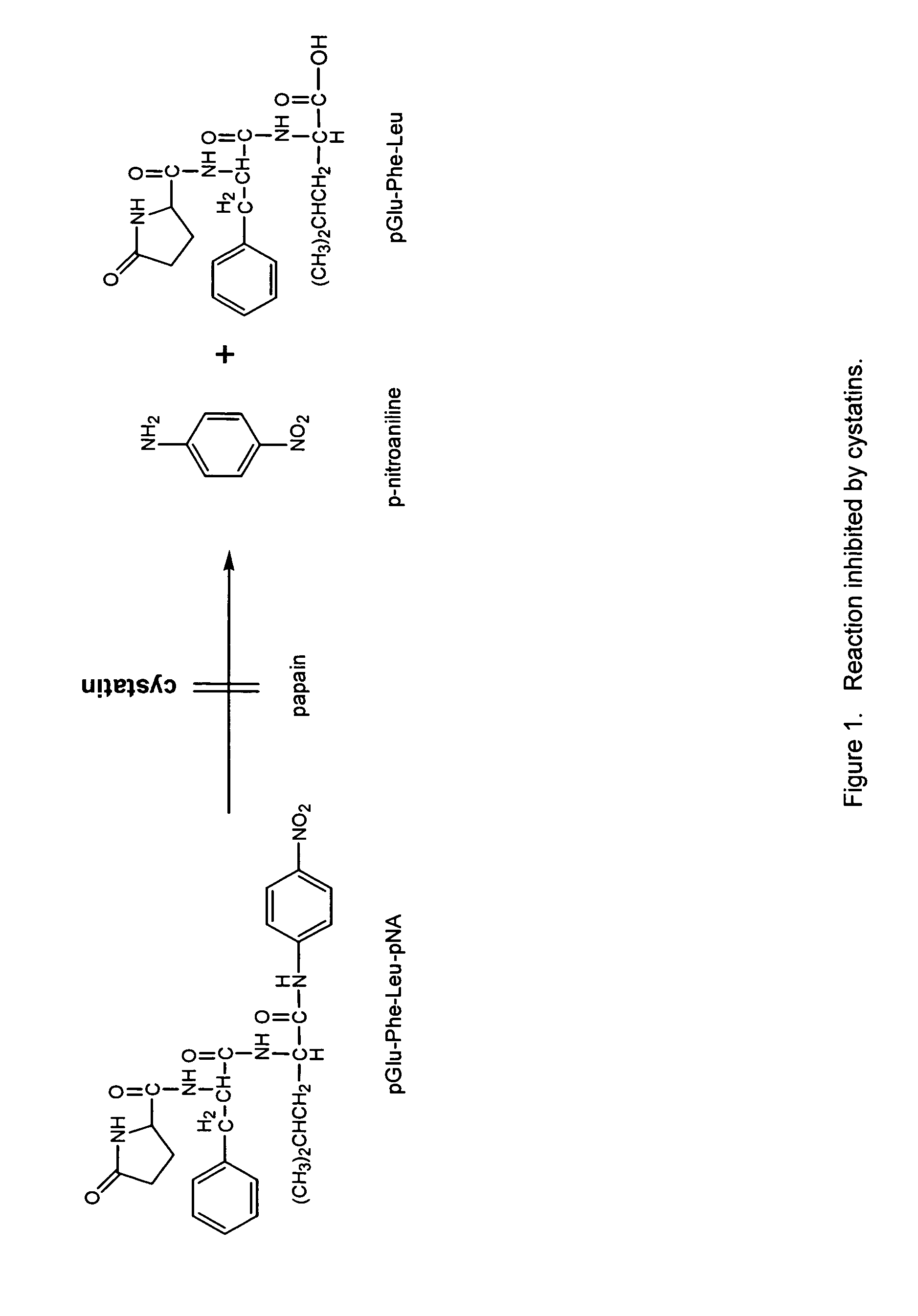Crop plant cystatin proteinase inhibitors encoding nucleic acids and methods of use
a technology of nucleic acid and cystatin protein, which is applied in the field of gene activity and development modulation of plants, can solve the problems of uncertain success and high cost, and achieve the effects of enhancing plant disease resistance, enhancing agronomic traits, and reducing cell death
- Summary
- Abstract
- Description
- Claims
- Application Information
AI Technical Summary
Problems solved by technology
Method used
Image
Examples
example 1
Transformation and Regeneration of Transgenic Plants
[0218]Immature maize embryos from greenhouse donor plants are bombarded with a plasmid containing the cystatin sequences of the present invention operably linked to a ubiquitin promoter and the selectable marker gene PAT (Wohlleben et al. (1988) Gene 70:25–37), which confers resistance to the herbicide Bialaphos. Alternatively, the selectable marker gene is provided on a separate plasmid. Transformation is performed as follows. Media recipes follow below.
Preparation of Target Tissue
[0219]The ears are husked and surface sterilized in 30% Clorox bleach plus 0.5% Micro detergent for 20 minutes, and rinsed two times with sterile water. The immature embryos are excised and placed embryo axis side down (scutellum side up), 25 embryos per plate, on 560Y medium for 4 hours and then aligned within the 2.5 cm target zone in preparation for bombardment.
Preparation of DNA
[0220]This plasmid DNA plus plasmid DNA containing a PAT selectable marke...
example 2
Agrobacterium-Mediated Transformation
[0230]For Agrobacterium-mediated transformation of maize with a cystatin nucleotide sequence of the invention, operably linked to a ubiquitin promoter, preferably the method of Zhao is employed (U.S. Pat. No. 5,981,840, and PCT patent publication WO98 / 32326; the contents of which are hereby incorporated by reference). Briefly, immature embryos are isolated from maize and the embryos contacted with a suspension of Agrobacterium, where the bacteria are capable of transferring the DNA construct containing the cystatin nucleotide sequence to at least one cell of at least one of the immature embryos (step 1: the infection step). In this step the immature embryos are preferably immersed in an Agrobacterium suspension for the initiation of inoculation. The embryos are co-cultured for a time with the Agrobacterium (step 2: the co-cultivation step). Preferably the immature embryos are cultured on solid medium following the infection step. Following this c...
example 3
Identification of the Gene from a Computer Homology Search
[0231]Gene identities were determined by conducting BLAST (Basic Local Alignment Search Tool; Altschul, S. F., et al. (1993) J. Mol. Biol. 215:403–410) searches under default parameters for similarity to sequences contained in the BLAST “nr” database (comprising all non-redundant GenBank CDS translations, sequences derived from the 3-dimensional structure Brookhaven Protein Data Bank, the last major release of the SWISS-PROT protein sequence database, EMBL, and DDBJ databases).
[0232]The cDNA sequences of the present invention were analyzed for similarity to all publicly available DNA sequences contained in the “nr” database using the BLASTN algorithm. The DNA sequences were translated in all reading frames and compared for similarity to all publicly available protein sequences contained in the “nr” database using the BLASTX algorithm (Gish, W. and States, D. J. Nature Genetics 3:266–272 (1993)) provided by the NCBI. In some c...
PUM
| Property | Measurement | Unit |
|---|---|---|
| temperature | aaaaa | aaaaa |
| temperature | aaaaa | aaaaa |
| pH | aaaaa | aaaaa |
Abstract
Description
Claims
Application Information
 Login to View More
Login to View More - R&D
- Intellectual Property
- Life Sciences
- Materials
- Tech Scout
- Unparalleled Data Quality
- Higher Quality Content
- 60% Fewer Hallucinations
Browse by: Latest US Patents, China's latest patents, Technical Efficacy Thesaurus, Application Domain, Technology Topic, Popular Technical Reports.
© 2025 PatSnap. All rights reserved.Legal|Privacy policy|Modern Slavery Act Transparency Statement|Sitemap|About US| Contact US: help@patsnap.com

